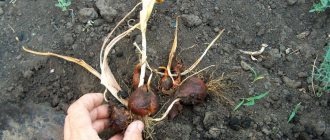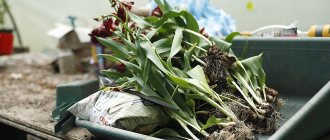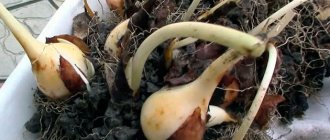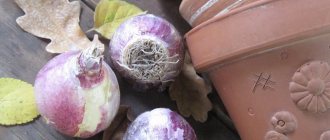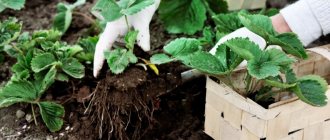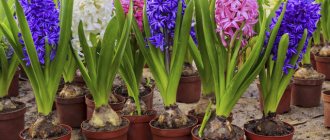Bulbous plants are popular among gardeners. Daffodils are especially in demand in the garden, because they are one of the first to delight with their flowering, and their cultivation does not require special conditions. When to dig up daffodil bulbs and when to plant them is of interest to all beginners. Daffodils lay flower buds in the summer - read more about all this in this article.
Why do they dig it up?
Daffodils are very delicate plants that do not like to be disturbed. You shouldn't replant them too often. The culture grows well in one flowerbed for 4-5 years; they should not be disturbed.
On a note! As an exception, planting material can be renewed after 3 years. But the bushes may weaken and not bloom the next season. The plant sometimes goes dormant for two growing seasons.
After flowering, you only need to dig up daffodils for a few months; you shouldn’t store them all winter. The only exceptions are heat-loving varieties that are not able to overwinter in cold climates.
Reasons why daffodil bulbs are replanted.
- Control or prevention of diseases and pests. A transplant is necessary if signs of any problems are noticed. The bulbs are dug up, inspected, diseased and damaged specimens are removed, and the rest are processed and disinfected.
- Bush rejuvenation. To ensure abundant flowering and large inflorescences, bushes are dug up and divided at intervals of 3-5 years. Every year several new bulbs are formed, gradually they become crowded in the nest, which does not allow them to develop normally.
- Transfer. If the flowers are reluctant to grow in the chosen area (not enough light, unsuitable soil), then the bushes are moved to a new flowerbed.
- Getting kids. Every year from 2 to 4 new babies appear in the bush. They can be removed every 2 years.
Important! For propagation purposes, only adult bulbs (at least 3 years old) are used.
Daffodil bulbs are dug up regularly, but not every year. To produce large flowers, bushes need a lot of nutrients. For this reason, they try to avoid dense plantings.
What happens if you don't dig up the daffodils?
If the flowers are not disturbed by digging them up, dividing them and replanting them in a new area, the clump will grow over time. The bulbs will crowd each other, gradually becoming smaller. Weak small bulbs will give the same weak and small flowers, and soon flowering will stop altogether.
When a plant is grown in one place for a long time, the soil is depleted and diseases accumulate. Experienced gardeners strongly recommend digging up and dividing clumps of daffodils every 5-9 years.
An exception can be made for some decorative varieties of narcissus, which get sick from frequent digging. Such plants are intended for decorating a site and can grow in one place for up to 12 years.
External signs of the need for a transplant
If you transplant daffodils from place to place too often, flowering may be rare. There is no need to disturb the bushes unnecessarily. You can understand the need to transplant daffodils by their appearance:
- the bushes turned into dense thickets;
- due to the growth of daffodils, the area of the flowerbed has increased;
- the plants show signs of disease and pests have appeared;
- the leaves have become shorter and the diameter of the inflorescences has become smaller;
- daffodil nests interfere with the growth of other crops;
- during active growth, yellow leaves appear;
- flowering lasts several days.
Any of these signs confirms that the flowers need to be replanted this year.
Timing for digging up bulbs
Daffodils do not have a specific, clearly defined period of rest, when the processes of sap flow and growth slow down. Therefore, there is no exact date for digging, but after flowering you should not remove them immediately.
Wait until the leaves turn yellow (approximately 1-2 months after flowering). During this period, the bulbs will take all the juices from the greens and prepare for the next season. But they don’t expect the tops to dry out completely. If the leaves fall off, it will be difficult to find the nests. The optimal period for digging up daffodil bulbs is around the end of June - beginning of July.
If yellow leaves spoil the appearance of the flowerbed, they are not removed, but braided and hidden under nearby plants. The roots of the plant take nutritional components from the above-ground part, so it is advisable to feed the crop immediately after flowering.
Signs of ripening daffodil bulbs:
- the leaves completely changed color from green to yellow;
- the bush fell apart in different directions and lost all its strength;
- the tips of the leaf blade dry out and fall off.
At this point, the bulbs will take all the nutrients from the ground part.
By the moon
All living organisms on earth, including plants, subtly respond to the phases of the Moon. Therefore, to obtain beautiful flower crops with a powerful root system and large inflorescences, you should take into account the recommendations of astrologers. Daffodils should be dug up and stored until planting in the fall in 2021 according to the lunar calendar.
| Month | Favorable days for digging bulbs | Unfavorable numbers |
| June | 1, 6–10, 27, 28 | 10-24 |
| July | 4–8, 25, 31 | 10-24 |
If flowers are in danger, then favorable days and the growing season are not taken into account when replanting.
By growing region
Frequent digging of bulbs leads to loss of their decorative properties. Missed flowering may also occur. When choosing the timing of harvesting bulbs, take into account the characteristics of the climatic region:
- southern regions - end of June;
- middle zone - early July;
- northern regions – early August.
The frequency of digging up daffodils also depends on the variety. Flowers are usually replanted after 4-5 years. But there are varieties that need to be dug up every 2 years.
At what time and how are bulbs dug out?
Normal storage of daffodil bulbs is only possible if they are dug up from the soil in a timely manner. You can tell that this deadline has already arrived by the dried leaves of plants. On average, this time falls in mid-June - July. But the dates may be shifted depending on the climatic conditions of the area.
If you delay collecting, the leaves will have time to fall off, and it will be quite difficult to find the bulbs. In addition, the plant may begin to grow new roots.
Harvesting daffodils should occur when there is no rain. In this case, use a pitchfork to avoid damage to the root system. The bulbs should be dug up together with a lump of earth, which is less dangerous for them.
After collection, the planting material is sent for drying, choosing dry, ventilated places, protected from bright light. It must be handled with extreme caution. Damaged bulbs will quickly begin to rot and will not be able to survive storage.
Those who decide to leave daffodils in open ground should cut off the remaining stems and leaves to ground level. You don't need to do anything else.
Preparing bulbs for storage
For cleaning, choose a day with good dry weather. Use a garden fork or shovel. To avoid damaging the bulbs, dig nests with a small supply of soil. It will fall off as it dries.
Not only the large heads are removed from the ground, but also all the small ones. They should not remain in the soil. After harvesting, the tops are not cut off; it is better to do this after drying.
In order for daffodil bulbs to survive until autumn, they are properly prepared. Immediately after digging, the flowers are placed in a cool place under a canopy to dry. The soil is raked after the top shell dries.
Important! You cannot speed up the process of removing soil from the bulbs by soaking all the bulbs in one basin. If there is a diseased specimen, the disease will spread to all plants. It is better to dry the flowers and then clean off the soil.
Among the peeled bulbs, culling is carried out.
- All bulbs are laid where signs of damage or signs of disease are visible.
- Small specimens are not suitable for further cultivation and are immediately discarded.
- If there are signs of damage, you can trim them. The chance that such a bulb will take root is small; it is more advisable to simply throw them away or burn them.
Selected healthy specimens are soaked for 15-20 minutes in a weak solution of potassium permanganate and dried well for 2-3 weeks. This will help prepare them for the new season.
Rules for planting narcissus bulbs
Before planting the bulbs, the soil should be plowed again (plowing depth of 18 to 20 centimeters) and leveled. Daffodil bulbs should be carefully inspected for damage.
After inspection, strong and healthy bulbs are treated with TMDT, which will protect them from rot, disease and mold.
Feeding is needed both during the formation of buds and when they bloom. The first takes place in the spring after the snow has melted; it is carried out with fertilizers of inorganic origin, which are dissolved in water intended for irrigation.
Mineral fertilizers must contain potassium, phosphorus, and sodium.
During the period of bud formation, fertilizing is done with the same fertilizers as the first time. You can also take a mullein solution (in the ratio of part mullein to 30 parts water), adding 15 grams of potassium salts and 30 grams of superphosphate for every 10 liters.
Thanks to feeding, the bulbs will receive useful substances that they will retain for the winter.
In order to protect plants from diseases, they must be sprayed before and after flowering. For processing, you can use a 2% TMTD etching solution.
Storage methods until autumn
Daffodil bulbs are different from tulips and hyacinths. They cannot be stored at home without soil for more than 1-2 months. There is no point in storing them any longer; they will simply dry out and lose their viability.
Store daffodils until autumn in a cool (+16-+18 oC) ventilated area in wooden or cardboard boxes. They must have holes for ventilation. If house temperatures are high, the bulbs will germinate ahead of time.
Do not store planting material in plastic boxes or plastic bags. The bulbs will have nothing to breathe, and they will begin to rot and become unsuitable for planting.
When to plant daffodils in the ground in the fall
To get beautiful blooms in the spring, plant the dug up bulbs back in the flowerbed in the fall. When choosing a date, take into account the climatic features of the area.
Important! Daffodils are planted from autumn until the onset of frost. It is important that the crop has 3-4 weeks to take root before the first frost hits.
After planting, the air temperature should not drop below +10 °C for several weeks. For the Moscow region and other regions of the middle zone, the optimal time for planting is the second half of September. In northern and cold regions, for example, in Siberia or the Urals, daffodils are planted at the end of August. In the southern regions, the dates are postponed to the end of September.
If the bulbs are left until spring, then they are planted in the flowerbed after the soil warms up to a temperature of +7 oC (late April - early May). But in this case, there will be no flowering this season, since the crop needs time to take root.
Useful tips
To avoid harming daffodils when replanting, you should consider simple tips.
- The leaves cannot be cut off immediately after flowering, since only by them can the maturity of the bulbs be determined.
- Don't delay digging up daffodils. If the foliage falls off, flowers will be difficult to find.
- If the question is about maintaining the health of the crop, then replanting is carried out at any stage of growth, even during the flowering period.
- If you store the bulbs in a plastic bag, their core will slowly rot, which will kill all the planting material.
- Store bulbs only in a ventilated area, as some varieties emit gas that can harm other plants.
Daffodils are unpretentious and common flowers that require a minimum of care. In order not to lose flowering and the bushes themselves, you need to periodically dig them up and treat them against pests and diseases.
Features of growing daffodils
Before you figure out when to dig up daffodil bulbs, you need to familiarize yourself with the general features of growing this plant in your garden.
When to dig up tulip bulbs after flowering
Narcissus is an unpretentious plant to grow and care for, but there are subtleties that you should definitely know. Bulbs should be planted in a place protected from drafts and with plenty of sunlight.
Important! Daffodils should not be planted in areas where other bulbous crops or perennial chrysanthemums grew a year earlier. The most suitable place is after legumes and cucumbers.
The plant loves neutral soil, which has been previously fertilized with rotted humus. If the soil is alkaline, then dolomite flour must be added to its composition; with increased acidity, the indicators are normalized with wood ash. Sand and peat are added to clay soil, and mineral/organic fertilizers and black soil are added to sandy soil.
The place for transplanting daffodils should be open and dry, since high humidity can provoke the development of fungal diseases.
